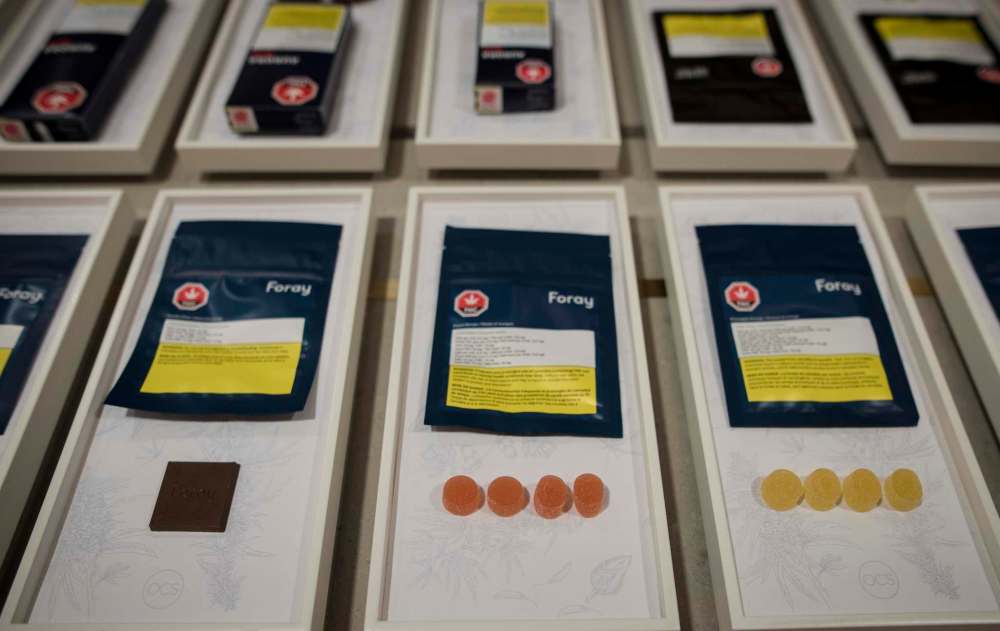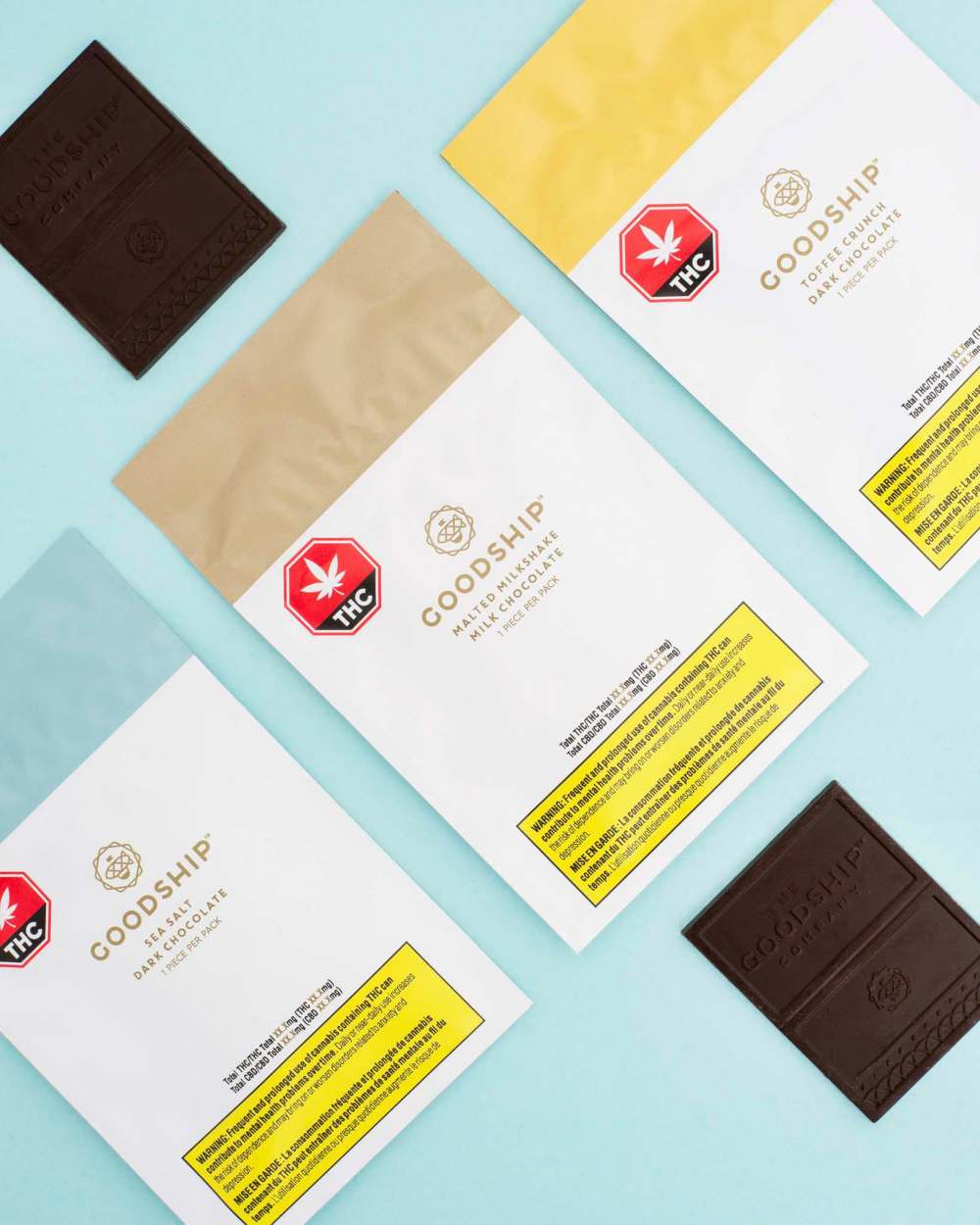Sweet treat? Chewy trauma? Digesting the details The second phase of marijuana legalization is putting all kinds of buzz-inducing edibles on store shelves; ingesting is a smoke-free option, but there are risks
Read this article for free:
or
Already have an account? Log in here »
To continue reading, please subscribe:
Monthly Digital Subscription
$0 for the first 4 weeks*
- Enjoy unlimited reading on winnipegfreepress.com
- Read the E-Edition, our digital replica newspaper
- Access News Break, our award-winning app
- Play interactive puzzles
*No charge for 4 weeks then price increases to the regular rate of $19.00 plus GST every four weeks. Offer available to new and qualified returning subscribers only. Cancel any time.
Monthly Digital Subscription
$4.75/week*
- Enjoy unlimited reading on winnipegfreepress.com
- Read the E-Edition, our digital replica newspaper
- Access News Break, our award-winning app
- Play interactive puzzles
*Billed as $19 plus GST every four weeks. Cancel any time.
To continue reading, please subscribe:
Add Free Press access to your Brandon Sun subscription for only an additional
$1 for the first 4 weeks*
*Your next subscription payment will increase by $1.00 and you will be charged $16.99 plus GST for four weeks. After four weeks, your payment will increase to $23.99 plus GST every four weeks.
Read unlimited articles for free today:
or
Already have an account? Log in here »
Hey there, time traveller!
This article was published 10/01/2020 (2159 days ago), so information in it may no longer be current.
At an undisclosed location somewhere in Winnipeg, a new candy factory is quietly nearing completion.
When it’s done, the 50,000-square-foot facility will be a cornucopia of confectionery, pumping out chocolates and caramels, biscuits and cookies, chewing gum and gummies, all with one key ingredient in common: cannabis.
Before the Trudeau government legalized and regulated marijuana in October 2018, an enormous cannabis candy plant would have been impossible. But more than a year after legalization, after Ottawa gave itself extra time to write new regulations governing commercially produced, cannabis-infused food, the products — known as edibles — have recently appeared at licensed weed stores across the country.
Winnipeg’s upcoming edibles factory is 80 per cent-owned by Vancouver-based AgraFlora Organics International; the remaining 20 per cent belongs to an as-yet unnamed Manitoba manufacturing partner.
In a press release, AgraFlora described the partner as “North America’s largest confectionery fruit slice manufacturer.”

AgraFlora CEO Brandon Boddy will say only that it’s a family business Winnipeggers will recognize when its identity is eventually revealed. But a regulatory filing dated June 6 says the junior joint-venture partner “has access to existing confectionery experts of Cavalier Candies Ltd.,” a Winnipeg firm that specializes in candy fruit slices.
“We’re working with these candy-makers who have been doing it for three generations, and we believe we’re going to put out unbelievable products,” says Boddy.
The Free Press wasn’t allowed to tour the facility, which is being renovated and is not yet licensed for production. But when it’s complete, Boddy anticipates a highly automated, state-of-the-art, government-regulated plant with robust security, an on-site research laboratory and stringent quality-control testing. He believes it will be the largest facility of its kind in North America.
No weed will be grown on site; that ingredient, in concentrated liquid form, will be shipped to Manitoba from elsewhere in Canada.
AgraFlora is spending more than $10 million to retrofit the Winnipeg plant. Why such a big gamble?
“We see it as, there’s a whole demographic of consumers that do not want to smoke or vape and would prefer an edible, whether it be to relieve anxiety, whether it be to help sleep, whether it just be for recreational use,” Boddy says.
● ● ●

Eating weed is far from new. The practice has a long recorded history in the Indian subcontinent, where a ground cannabis mixture called “bhang” is still consumed today, usually in a drinkable form.
Nor is Canada the first national government to grapple with regulating edibles. In 1893, the British colonial government in India launched a commission on the use of what were called “hemp drugs,” driven by concern that they caused insanity. The resulting report, thousands of pages long, documented the many roles of cannabis in Indian society, including the religious use of bhang by Hindus and Muslims alike.
Give it a go? Start slow
Want to give cannabis edibles a try for the first time? Follow these tips to reduce the risks of having an unsatisfying experience:
Seek out low doses containing 2.5 milligrams of THC or less. Licensed store employees should be able to help you find an appropriate product.
Clear your schedule and give yourself time to feel the effects. Onset time could take between 30 minutes and two hours, and feeling the full effects could take up to four hours. The acute effects of ingested THC could last as long as 12 hours, Health Canada advises.
Don’t plan to drive or operate heavy machinery after using edibles. Avoid using other substances, including alcohol, at the same time as cannabis. Keep edibles away from children and pets.
Consider any pre-existing medical conditions, including cardiovascular and mental-health conditions, that might make weed use inadvisable.
If you’re concerned about whether you’re healthy enough to use edibles, ask your doctor first.
“To forbid or even seriously to restrict the use of so holy and gracious a herb as the hemp would cause widespread suffering and annoyance and to the large bands of worshipped ascetics deep-seated anger,” warned one colonial administrator in his notes to the commission.
Religious sacrament might not be why Canadians consume edibles today, but we’re definitely using them. Forty-four per cent of cannabis users surveyed by Health Canada in 2019 said they use edible forms, making it the second most popular weed product after dried flower. Research suggests the use of edibles is driven by the perceived harm of smoking, an appreciation of long-lasting effects and a desire for discreet consumption.
“I could be sitting here at my desk having a coffee and a cookie, and no one would be the wiser,” says Andrew Papadopoulos, a University of Guelph public health professor who recently reviewed the existing academic research on edibles.
Edibles are most likely to be used by current weed users, Papadopoulos says. But they also appeal to people who are new to the drug, and some might experience unwelcome effects, especially if they over-consume.
“That’s where you where get a lot of the emergency-room visits, 911 calls,” he says. “People start to panic.
“And because they are naive users and they may have over-consumed, there is a lot of anxiety with that. Now people know they have cannabis in their system, and they’re not quite sure — they’re having a feeling that they don’t typically have, and therefore they start to feel very nervous about the product and about their high, and 911 calls have originated because of that.”
● ● ●

Edibles’ reputation for potency is based in different pharmacological dynamics when the drug is ingested compared to when it’s inhaled.
People who smoke or vape generally feel the effects within a matter of minutes, as the psychoactive chemical compound delta-9-tetrahydrocannabinol (better known as THC) quickly enters the bloodstream via the lungs. That fast-acting effect allows even novice users to adjust the dose according to their response, a concept known as titration, familiar to any drinker who’s taken a break after one too many beers.
Ingested cannabis takes a slower journey through the body, from the stomach to the liver, where it’s transformed into a different type of THC called 11-hydroxy-THC. Being processed through the liver significantly increases the time before onset, which could take hours for some users. Without a quick response to the drug, it can be harder for novice users to adjust their dose.
For most users, the high from smoking weed wears off relatively quickly — official Health Canada guidance advises that acute effects can last up to six hours. But edibles have more staying power, with Health Canada advising of effects that could last twice as long.
Beyond the slower onset and longer duration, some research has suggested that the 11-hydroxy-THC is more potent than the delta-9-THC. But that theory “has not been borne out by more recent studies,” leading medical cannabis researcher Dr. Ethan Russo wrote in an email.
Russo said his own research developing the GW Pharmaceuticals cannabis drug Sativex suggested the two kinds of THC were actually equivalent in psychoactive potency, but the practical difficulties of measuring THC levels in the brain means it’s “likely to remain an academic question for some time.”
Regardless of why edibles pack such a punch, their potency has become something of a cultural touchstone. In a famous 2014 column, New York Times columnist Maureen Dowd chronicled a harrowing all-night experience in her Colorado hotel room after eating an entire cannabis-infused chocolate bar of unspecified strength.
“As my paranoia deepened, I became convinced that I had died and no one was telling me,” Dowd wrote. (She later found out she should only have eaten one-sixteenth of the chocolate bar, “but that recommendation hadn’t been on the label.” Colorado later instituted standard serving sizes for edibles.)

Dowd’s tale of delirium highlights the core conundrum of edibles: they have the potential for a powerful, enduring high delivered in a form that’s potentially more attractive than smoking to inexperienced users. If they don’t feel the effects quickly, those users might assume they simply didn’t take enough and keep eating, just as Dowd did. When the THC finally does kick in, they’ve taken more than intended and they’re in for a formidable psychotropic ride.
Versions of the “too much edibles” story have made international headlines, such as the Toronto police officer who, in 2018, radioed for rescue after eating cannabis-infused chocolate lifted from a raided dispensary.
Perhaps the best-publicized case is the tragic story of Levy Thamba, a 19-year-old college student who died in 2014 after jumping from a Denver hotel balcony. Thamba had eaten a cookie — purchased legally by an older friend — that contained 65 milligrams of THC.
A store clerk reportedly advised them to break the cookie into six servings and take one at a time. Thamba initially ate a single piece, but finished the rest of the cookie not long after; he jumped to his death a few hours later.
● ● ●
Thamba’s death is an unusual but terrifying example of the potential drawbacks of edibles, especially among the uninitiated. But the risks are easily reduced with planning and proper dosing.
Rielle Capler, a post-doctoral research fellow with the British Columbia Centre on Substance Use, last year called for Health Canada to set a standard 2.5-milligram dose of THC for edibles. She says the idea, which turned into a Huffington Post op-ed co-written with fellow PhD Jenna Valleriani, grew out of a think-tank where various stakeholders discussed appropriate dosing.

“I think what we were thinking was, ‘What is the effect of a beer, a standard alcohol drink?’ What is the effect, what is the level of intoxication that that provides? And I think just based on the average person, the majority of people, we felt that the 2.5 milligrams could be seen as the equivalent to that,” says Capler.
“And people have different tolerances, so you’re going to have people saying, ‘Well I use 200 milligrams, so it should be 200 milligrams.’ But I think they’re conflating the issues of a standard dose, which gives guidance to the majority of the population, and a maximum per unit or per package (dose).”
Even though 2.5 milligrams might not have much of an effect on an experienced user with a developed tolerance, Capler believes it should be enough for the average adult to notice an effect within a few hours of ingestion.
“That might be very pleasant, they might really enjoy that and be very happy with that, and then go up in very small increments,” she says.
Health Canada never officially set a standard dose for edibles, but it did set an upper limit of 10 milligrams of THC, both per unit and per package. That means one package of cannabis candy could contain a single piece with 10 milligrams, or two pieces with five milligrams each or four pieces with 2.5 milligrams each — but Canadians will never find more than 10 milligrams in a single package of government-regulated edibles.

It’s legal for users seeking higher doses to make their own edibles at home.
“The limit draws heavily on lessons learned from, and the limits established by, U.S. states that have legalized cannabis,” the federal government wrote in an official description of its new regulations.
“It’s important to note that the 10 milligrams limit does not represent a safe ‘dose’ or standard ‘serving size’ for THC, particularly for new and novice consumers.”
Health Canada guidance does recommend new users stick to edible products with 2.5 milligrams of THC or less, warning it could take as long as four hours to feel the effects. Still, Capler worries that the federal regulator’s per-package THC limit might have inadvertently sent a message to some users that 10 milligrams is an appropriate single dose.
“But I would say that many of the manufacturers of these products are aware that people want smaller doses than that,” she says.
“And so they are going to be producing products that have lower THC levels… the manufacturers want their consumers, their clients, to have a good experience. And if they have higher doses of THC they might not, and then they’ll never use it again.”
Papadopoulos says potency regulations seem like a reasonable step to help avert possible harms. But he says harm reduction — strategies that seek to manage and mitigate behaviours such as drug use without necessarily relying on abstinence — also requires public education. Even limiting the amount of THC per package, or per piece, won’t necessarily stop users from taking too much.
“It’s the same with alcohol… you know what a serving should be, but it wouldn’t stop you from over-consuming,” he says.
“So having both the individual knowledge and the regulatory support would hopefully create a web of harm reduction that will make edible cannabis a safer product to use within our communities.”

The Liquor, Gaming and Cannabis Authority of Manitoba has been trying to get that harm reduction message across for months, advising Manitobans to choose edibles with lower amounts of THC, to keep them away from kids and pets and to identify cannabis-infused foods to guests to avoid unexpected highs.
Among other provinces, Quebec has taken the most restrictive stance with a regulation requiring that edibles “not be sweets, confectionery, dessert, chocolate or any other product attractive to persons under 21 years of age.”
In Manitoba, where cannabis foods have started arriving at retail outlets over the last few weeks, the provincial government’s key edibles-related policy has been a bill to ban their consumption in public places, matching a public ban on smoking or vaporizing cannabis.
● ● ●
On the unregulated market, cannabis has been infused into almost every food product imaginable, from the usual gummies and chocolates to more exotic items such as honey and ice cream, with THC doses reaching into the hundreds of milligrams.
Predictably, the regulated market is more restrictive. Federal regulations forbid edibles from requiring freezing or refrigeration, which rules out a whole category of products. Meat, poultry and fish are also banned, with an exception for dried products such as jerky. Added caffeine is banned, although naturally occurring caffeine found in chocolate, tea and coffee is allowed in limited amounts.

Mixing edible cannabis with alcohol is generally prohibited by Health Canada, although it’s permitted in very small amounts to allow for foods and ingredients with some fermentation — pass the cannabis vinegar, please. Beverages can’t be represented with any terms related to alcohol, such as “beer” or “wine.” Producers aren’t allowed to add vitamins or minerals to their food products and can’t make any food-related health claims on the packaging.
Given the possibility that children could get their hands on products, Ottawa has forbidden sales of anything weed-related — including edibles — that have an appearance or shape that might appeal to young people. It’s a broad requirement with room for interpretation, but a Health Canada policy document offers example of dinosaur- and unicorn-shaped edibles as being offside.
The prohibition on appealing to youth doesn’t mean edibles have to be tasteless, though: products available on the legal market so far include chocolate bars and squares, breath mints, chocolate cookies and fruit-flavoured gummies. Beverages are expected to roll out in the coming months. Like other weed products, regulations require that edibles come in child-resistant, plain packaging with a warning symbol and health message, along with strict limitations on branding and marketing.
Those packaging regulations were made with public health in mind. Ray Gracewood, senior vice-president of marketing and communications with New Brunswick-based manufacturer Organigram, says the rules make it harder for legal cannabis brands to compete with each other and the illicit market.
Gracewood gives the example of what he calls “glamour copy,” an on-package blurb that describes how a product was made or where the ingredients were sourced. Such descriptions are common on regular food products, but are prohibited on cannabis because they might be construed as promotional.
“I think there’s only so much that you can talk about that makes your brand or your product special, and when the rules prohibit you from telling that story, or giving people a sense of education on how it’s different than products in the illicit market, you’re doing consumers a disservice,” he says.
“Whereas you would have that ability in the illicit market, you (also) have that ability in a lot of other industries. And without that, obviously, it makes it far more difficult for consumers to get educated on what makes one product stand out against another.”
● ● ●

With legal sales of edibles only just beginning, it’s too early to predict whether Organigram and other regulated producers can capture significant market share from their illicit competition. Statistics Canada estimates that 28 per cent of weed users in the third quarter of 2019 got all they used from legal sources only, with older consumers more likely to choose legal providers.
Edibles have reportedly been selling out quickly at licensed retailers that have managed to stock them. But some users have complained that prices are excessive and argue that 10 milligrams of THC per package simply isn’t enough to get high.
Rick Macl, president of Brandon-based supply and accessory store Growers n’ Smokers, bought and tried every legal edible he could find as soon as they were in stock at a local store in December. He says he “felt nothing” after eating his entire haul which, in total, contained 50 milligrams of THC. (To be fair, Macl describes himself as an experienced user with a high THC tolerance.)
“Most of them tasted like crap,” he says. “And I’m like, ‘Holy crap, I just went and spent almost $100, and (got) nothing to show for it. When, meanwhile, I could have bought a gram of good weed for, like, $5 off the street and got a buzz.”
Chocolates with 10 milligrams of THC are currently listed on licensed Manitoba retail websites for between $7 and $9. For comparison, one illegal online dispensary is selling a “Cookies N’ Cream Crack Bar” said to contain 300 milligrams of THC for $20.
Proponents of the legal industry point out that unregulated edibles may not contain as much THC as sellers claim, and argue that 10 guaranteed milligrams of THC in a government-regulated product might be stronger than the skeptics think.
Winnipeg cannabis chef Allan Pineda thinks 10 milligrams of THC at legal prices might be reasonable “for maybe the basic (recreational) consumer, sure.” But for medical cannabis users who tend to seek higher doses, he thinks legal edibles are unaffordable.
“It’s too expensive, 100 per cent too expensive,” says Pineda, who is planning to offer edibles-making courses to the public.
“I mean, people that already are making it at their homes know how much it costs to make.”
Whatever the potency of legal edibles, they’re bound to be too strong for some. At some point in the coming months, some Canadian somewhere is all but guaranteed to over-indulge, have a bad experience and take the story to the media.
With alcohol — by far Canada’s most popular drug — Capler says users learn their limits through experience.
“They know that they can have one drink and then still go about their activities, but if they’re going to be going out and drinking, or having a bottle of wine with dinner, that it’s going to change how the rest of their evening plays out,” she says.
“So I think people have to just think about (edibles) in the same way. It’s a privilege and a right now to use cannabis recreationally, but it comes with responsibilities.”
solomon.israel@freepress.mb.ca
@sol_israel









